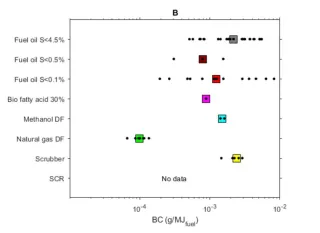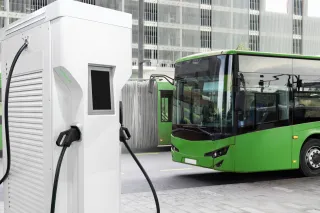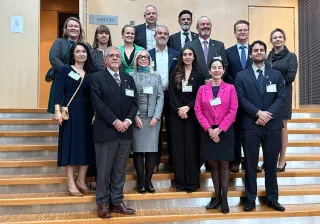A comprehensive literature review and discussion by researchers from Finland, the U.S., Greece, Canada and Japan studied opportunities to achieve (near)zero-emissions. The adverse impacts of shipping on the climate, health and the environment could be reduced by using carbon-neutral fuels in combination with clean engines and efficient exhaust aftertreatment technologies if the production capacity and affordability of carbon-neutral fuels improve. This review of technologies and their impact on emissions increases understanding of reducing ship emissions with these technologies.
Time for action
Warning messages on climate change are becoming increasingly serious and all possible actions are needed to address this threat. The International Maritime Organisation (IMO) has an ambitious strategy to cut the shipping sector’s carbon intensity by up to 40% by 2030 and 70% by 2050 in comparison to 2008. Ship emissions have harmful effects on climate, air quality, human health and the environment. Estimates indicate that shipping causes approx. 250,000 premature deaths and 6.4 million childhood asthma cases annually, since ships travel near densely inhabited coastal areas. This study focused on how fuels and technologies impact greenhouse gas and other harmful emissions from ship engines, and which are the best solutions to reach the goal of zero-emission shipping. Ship fleets are diverse (Fig. 1), and the optimum solutions depend on the ship, route and region.

Potential in carbon-neutral fuels
The carbon-neutrality of fuels depends on their GHG emissions, including carbon dioxide (CO2), methane (CH4), and nitrous oxide emissions (N2O). Non-gaseous black carbon (BC) emissions also have high global warming potential (GWP). Carbon-neutral fuels produced from biomass, waste or renewable hydrogen and captured CO2 have the potential to substantially contribute on reducing ship emissions. Hydrogen gas technologies, batteries and ammonia options are not currently available for large ships and their feasibility will be seen.
Fuel technologies are of the primary importance when dealing with GHG emissions from shipping, since the demand for energy in the maritime sector is expected to remain at approximately 310 Mtoe in 2050 despite of substantial energy efficiency improvements achievable by e.g. design, waste heat recovery, alternative maritime routes, regional trade, and shifts to rail cargo. Biofuels could be increasingly directed to shipping and aviation as road-transport switches to batteries. However, the quantity of compliant fuels may fall when they have to meet stringent criteria, such as RED II. This makes renewable hydrogen-based e-fuels an interesting option for shipping along with the increasingly available renewable electricity (Fig. 2).

This review shows that demand for carbon-neutral fuels is high due to existing and future emission regulations and zero emission targets. This is especially true for products resembling current fossil marine fuels (diesel, LNG or methanol) that are compatible with proven technologies as “drop-in” fuels. Combining carbon-neutral drop-in fuels with efficient emission control technologies would enable (near-)zero-emission shipping and could be adaptable in the short- to mid-term. Methane, methanol, diesel-type molecules are all acceptable if they are carbon-neutral and meet sustainability criteria. Hydrogen-based e-fuels could become important building blocks in the transport sectors where other forms of electrification are difficult. E-fuels could also act as renewable grid storage, thus accelerating the transition to renewables. However, the viability and production of carbon-neutral raw materials are limited in the short term, and fossil fuels may be used for longer than desired, which makes carbon capture on-board ship an interesting option.
The need to remove harmful emissions
Emissions that are harmful to health or the environment have to be removed by means of fuel, engine or exhaust aftertreatment technologies. Harmful emissions include nitrogen oxides (NOx) and sulphur oxides (SOx), which are regulated at this time, as well as emissions likely to be regulated in the near future. These are black carbon (BC) and methane emissions. Other harmful emissions are ammonia (NH3), formaldehyde, particle mass (PM) and number emissions (PN). Black carbon emission (Fig. 3) contributes to global warming and also adversely affects health and the environment. The IMO has been studying the impact of BC emissions from international shipping in the Arctic since 2011. Reducing emissions may involve modifying the fuel, engine (or both), or adapting the exhaust aftertreatment technology.

Investments can save money by reducing the costs to society
Substantial investments are needed to introduce carbon-neutral fuels, but they will also provide savings by reducing the costs to society caused by harmful emissions. This justifies support mechanisms and investing in clean technologies. The benefits of carbon-neutral fuels include lower external costs, and the fact that drop-in fuels do not require new infrastructure for transport and delivery. Calculations indicate that the emissions from 260 Mtoe of residual marine fuel cause external costs of 433 billion euros annually. Those costs could be avoided by using modern marine engines, carbon-neutral fuels and the best exhaust aftertreatment options. The external costs are probably underestimated when considering the recent natural disasters caused by climate change. Marine fuel choices are driven also by non-technical aspects, such as public acceptance, fuel availability and prices. Hence, evaluations and solid evidence are needed to guide decision-making towards the best choices for the future.

No clear “winning” fuel
An evaluation of the three e-fuels (e-methane, e-methanol and e-Diesel) with fossil fuels and hydrogen/batteries as references (Table 1) reveals the pros and cons for the best technologies for reducing emissions. The three options had equal scores, although they were accumulated from different aspects. As a result, there seems to be no “winning” fuel. All these e-fuels, or respective biofuels, can be used in existing engines if carbon-neutral fuel production volumes increase.

Combining carbon-neutral drop-in fuels with efficient emission control technologies (also for retrofitting) would enable (near-)zero-emission shipping. This could immediately and simultaneously mitigate GHG and pollutant emissions. Substantial savings in external costs to society caused by ship emissions justify the regulations, policies and investments needed to support this development.
Reference: Aakko-Saksa, P. T., Lehtoranta, K., Kuittinen, N., Järvinen, A., Jalkanen, J.-P., Johnson, K., Jung, H., Ntziachristos, L., Gagné, S., Takahashi, C., Karjalainen, P., Rönkkö, T., and Timonen, H.: Reduction in greenhouse gas and other emissions from ship engines: Current trends and future options, Progress in Energy and Combustion Science, 94, 101055, https://doi.org/10.1016/j.pecs.2022.101055, 2023.






